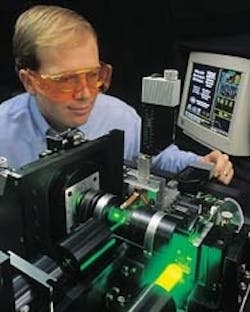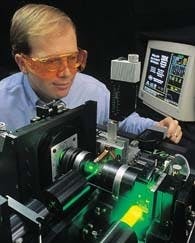Holographic storage delivers high data density
Besides providing high speed, holographic optical storage has now demonstrated data storage at densities eighty times larger than conventional optical storage.
IBM Holographic Optical Storage Team
Holographic data storage is finally approaching practical implementation, thanks to lower-cost enabling technologies and progress in holographic recording materials.1 In addition to pursuing write-once three-dimensional (3-D) disks2,3 and holographic content-addressable data storage,4 researchers are exploring fast, high-density, erasable holographic memory that could provide submillisecond access to stationary blocks of media for applications such as video-on-demand, on-line archiving, and Web databases (see Fig. 1). At IBM Almaden, researchers have made significant progress toward developing such a memory since their work was first reported in Laser Focus World (see Nov. 1996, p. 81). In fact, they recently demonstrated densities eighty times larger than conventional optical storage.
Holographic technology stores pages of information as optical interference patternspatterns that form when two coherent laser beams intersect within a thick photosensitive optical material (see Fig. 2). The object beam contains data that has been imprinted by a spatial light modulator (SLM). The reference beam can be as simple as a collimated beam, as long as it is easy to reproduce.
Through chemical and physical changes in the photosensitive medium, a replica of the interference pattern is stored as a change in the absorption, refractive index, or thickness of the photosensitive medium. Illuminating the interference grating with one of the two recording waves causes some of the incident light to be diffracted. Illuminating the stored grating with the reference wave reconstructs the object wave and so forth. With thicker storage media, many holograms can be superimposed in the same volume by changing the reference wave angle or laser wavelength. Illuminating the stored gratings with the reference wave used to store a specific page (same angle and wavelength) allows the readout of any desired data page independently.
FIGURE 1. Using Fourier transform lenses with a 30-mm focal length and a 1-million-pixel SLM, IBM Almaden's Demon II holographic digital data storage engine has demonstrated areal storage densities of nearly 400 bits/µm2.
With this technique, the theoretical limits for storage density approach tens of terabits per cubic centimeter. Holographic data storage also promises fast access times because the laser beams can be moved rapidly without inertia. With the inherent parallelism of this page-wise storage and retrieval, a very large compound data rate is possible with a large number of relatively slow and therefore cheap parallel data channels.
To retrieve data without error, the object beam must pass through a high-quality imaging system. For high density, the imaging system must have a short focal length to allow tight focusing of the large SLM pixel array at the storage media. Optical aberrations, diffraction from the aperture used to limit the volume of media exposed, magnification error between the SLM and detector, and misfocus or misregistration of the detector array can spread energy from one pixel to its neighbors, producing errors in the retrieved data.
Once the optical system is configured to successfully pass the SLM data to the detector array through a small aperture at the storage material, the next step is to provide independent recording and retrieval of each hologram. This process adds two considerations to the design. First is the possibility of interpage crosstalk between the multiplexed holograms. Second, the average diffraction efficiency will drop by a factor of four every time the number of multiplexed holograms doubles. This effect is a consequence of sharing the finite dynamic range of the storage material among the superimposed holograms. Achieving high areal density becomes a balancing act between the interpixel noise introduced by the small aperture and the loss of signal associated with recording multiple holograms.
Extending high density to high capacity
IBM Almaden has already developed several powerful data-modulation codes and signal-processing techniques for holographic data storage using its Demon I optical bench test platform. On the other hand, the firm's Prism holographic materials tester used custom optics to demonstrate pixel-to-pixel matching between the SLM and detector providing "megapel" data pages of 1024 x 1024 pixels. Based on the results of these two research fronts, the team then built a third platform called Demon II to demonstrate high areal density (see Fig. 1). This platform combines large megapel data pages with the short-focal-length optics required for high density.
In one experiment, 1000 holographic data pages, each with 1 million pixels, were angle-multiplexed in a common volume of lithium niobate. With an effective transverse aperture of 1.6 x 1.6 mm2, the demonstrated areal density was 394 pixels/µm2. In comparison, an audio CD has a density close to 0.7 bits/µm2, and a DVD disk has 4.5 bits/µm2. The magnetic disk in the 1-Gbit IBM Microdrive has a density approaching 23 bits/µm2.
FIGURE 2. With holographic data storage, the data are imprinted onto the object beam when light shines through a spatial light modulator. Two lenses image the data through the storage material onto a detector array (here a charge-coupled device). A reference beam intersects the object beam in the storage material to provide a means to store and retrieve holograms (left). A backward-propagating or phase-conjugate reference wave reconstructs an object wave that also propagates toward its original source (right).
Retrieved data pages were then post-processed to compensate for global page misregistration and optical distortion (see Fig. 3 on p. 124). The processed data pages were then decoded with a strong 8-bits-from-12-pixels modulation code. The resulting worst-case raw bit-error rate (BER) before error correction was close to 10-3, sufficient to deliver a user BER of 10-12. Given the 5.5-mm hologram thickness, this result corresponds to approximately 1% of the first-order theoretical volumetric density limit of 1/l3.
The success of the Demon II platform is due to excellent imaging fidelity (pixelated data arrives at the right detectors) and tight focusing of the object beam (holograms can be stored using very little volume). These two features are possible because the system's optical design reduces the optical aberrations of the short-focal-length optics, particularly distortion. To scale fast-access holographic storage to high capacity, though, this same high density must be achievable at many storage locations, without moving the storage media. The correspondingly greater demands on optical imaging performance soon limit the capacity achievable along this path to commercially uninteresting limits.
One option proposed in the past to bypass these imaging constraints is phase-conjugate readout. Once a hologram is recorded, the wavefront reconstructed by a phase-conjugate readout beam will retrace the path of the incoming object beam in reverse, thus canceling out any accumulated phase errors. High page fidelity would then be possible with an inexpensive lens or with no imaging lenses at all.
Several drawbacks, however, suppressed widespread use of this technique, including the realization that any imperfections in matching the phase-conjugate readout beam to the original recording reference beam would introduce errors in a retrieved data page. The IBM Holographic Optical Storage Team, however, recently showed that the reference beam produced by a self-pumped phase-conjugate mirror (made of barium titanate) could retrieve pages containing 1 million pixels onto a camera with very few bit errors.
FIGURE 3. This 9 x 9 pixel pattern is imaged from the SLM to the CCD under perfect conditions (a), with a half-pixel offset in both x and y (b), and after post-processing with IBM's shift-compensation algorithm (c).
Scientists also were concerned that many pairs of phase-conjugate reference beams would be required to read the many different holograms recorded within the same volumeand long-term maintenance of these beams might be impractical. To solve this problem, the IBM team developed an architecture that allows phase conjugation and multiplexed holographic storage to co-exist.5 In essence, a buffer hologram separates them into two successive steps. This makes it easy to multiplex holograms at a large number of separate storage locations using only one spatial light modulator and one detector array. In addition, since such a system only contains a single pair of phase-conjugate beams, it never needs to wait for the phase-conjugate mirror to respond. For such a technique to progress to a practical approach, however, the recording material will need to support both read-write access and nonvolatile storage.
Material matters
Photorefractive materials for holographysuch as lithium niobate, strontium barium niobate, and barium titanatereact to the light and dark regions of an interference pattern by transporting and trapping electrons, which leads to a local change in the index of refraction. Because subsequent illumination can rearrange the trapped charge, it is possible to erase recorded holograms and replace them with new ones. It is also possible to erase stored holograms during normal readout, however. In addition, thermal excitation could lead to gradual erasure of holograms in the dark. While the recorded holograms can be made resistant to erasure during readout using separate thermal or electronic processes, this technique affects all of the stored holograms within a volume simultaneously and can be slow and cumbersome.
One alternative is to record at a wavelength of light that is only absorbed by the crystal in the presence of a third gating beam of different wavelength. This beam would be present during recording and switched off during information readout, hence no erasure. This low absorption also allows read-out of holograms through other storage locations, which extends the potential capacity of the phase-conjugate buffer system. Conventional photorefractive materials can be optimized for this gated, two-color recording process by changing the ratio of lithium to niobium in the compound or by doping crystals with two dopants such as manganese and iron.
Although recent research has led to improvements in both the sensitivity and dynamic range of materials for nonvolatile read-write holographic storage, further improvements will be needed before prototype read-write holographic storage systems can be built. Recent developments, however, have made clear how to build high-density and high-capacity systems once improved materials become available.
Members of the IBM Holograhic Optical Storage Team are GEOFFREY BURR, HANS COUFAL, C. MICHAEL JEFFERSON, JOHN HOFFNAGLE, MARK JURICH, ROGER MACFARLANE, AND ROBERT SHELBY at IBM Almaden Research Center, D2-k11, 650 Harry Road, San Jose, CA 95120; e-mail: [email protected].
REFERENCES
- H. J. Coufal, D. Pasaltis, and G. Sincerbox, eds. Holographic Data Storage, Springer-Verlag (2000).
- J. Ashley et al., IBM J. R&D 44(3), 341 (May 2000).
- Opt. and Quant. Elect. 32, 341-417 (2000).
- G. W. Burr et al., Appl. Opt. 38(32), 6779 (1999).
- G. W. Burr and I. Leyva, Opt. Lett. 25(7), 499 (2000).

